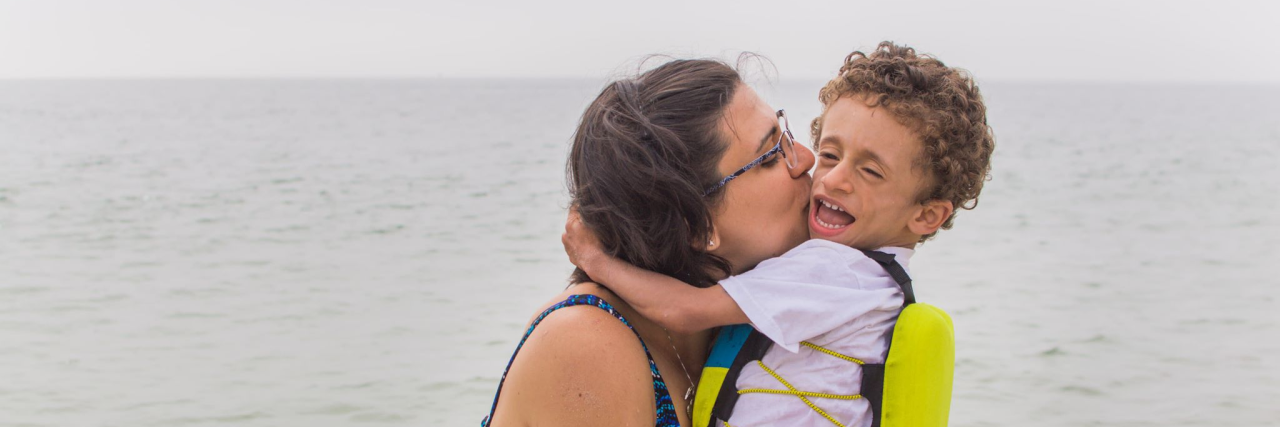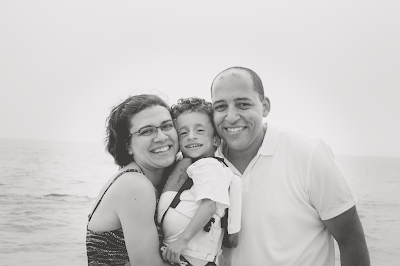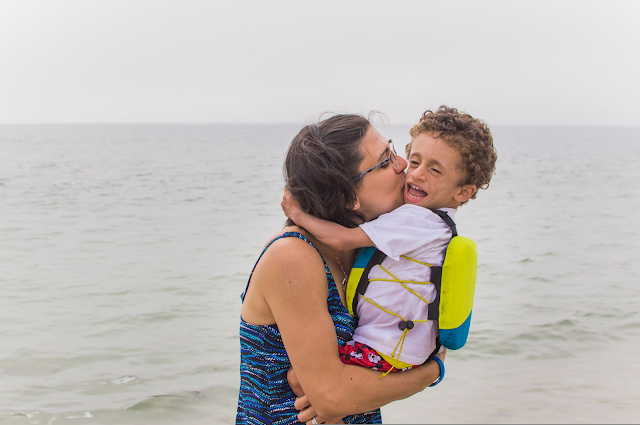When a Teacher Told a Child Not to be 'Afraid' of My Son's 'Different' Appearance
Kara Felton was sitting on a bench at the playground, watching her son, Julian, play. Upon spotting a free patch of wood chips, 3-year-old Julian decided to explore. This, however, was unacceptable to another 3-year-old playing nearby. Little did Julian know, this other kid had claimed that foot-wide section of wood chips for himself, and Julian was an intruder barging in on his territory. Catching sight of Julian in his favorite wood chip patch, the boy did what any 3-year-old property owner would do in such a case: he became visibly upset.
Only the two boys and Kara knew exactly what occurred to cause such a scene, but a preschool teacher was on duty and intervened. Not knowing the cause of the boy’s meltdown, the teacher picked him up and pointed to Julian, still playing innocently in the woodchips. “Don’t worry,” she told the tear-filled boy, voice raised for the entire playground to hear. “You don’t have to be afraid of him, his face is just different.”
Julian has congenital generalized lipodystrophy. Despite having a very easy, enjoyable pregnancy, Kara noticed when she gave birth to Julian that he had little subcutaneous fat. He had beautiful, but prominent, eyes and was very muscular. Kara did all she could to build him up—when eating more foods to fatten up her breast milk failed, she continued to think that perhaps she was failing to provide for her son. But it was no use, and sure enough, when he was 4 weeks old, Julian was diagnosed with lipodystrophy.
It was incredibly lucky that Julian got a diagnosis. The endocrinologist happened to have a friend whose daughter had a form of partial lipodystrophy, so she knew about the rare condition. Even though Julian now has a diagnosis of congenital generalized lipodystrophy, there are still unknowns, as Julian does not have any of the known subtypes of CGL.
Kara and her husband, Nicholas, were relieved to get this diagnosis. Upon getting the information of Dr. Garg, a lipodystrophy specialist in Texas, Kara felt immense relief that she was in contact with a knowledgeable expert. She also thought that Dr. Garg could perhaps answer some other questions. Kara has hemihypertrophy, which means that half of her body is larger than the other side, so she also grew up looking “different.” While looking at Julian’s small, muscular body, she recognized that it resembled the right side of her own body.
As it turns out, Kara also has a form of lipodystrophy. Her smaller, right side also has little fat, but her left side’s fat cells provides enough leptin hormone that she did not exhibit any other symptoms. Both Kara and Julian are unknowns when it comes to lipodystrophy: no one else has been found with either of the same conditions, and their genetic makeup is not understood. Knowing how it feels to be different, Kara hopes to create a world in which ‘different’ is accepted and Julian can be recognized as the silly, happy, special boy he is. But when adults point out children like Julian and use the world ‘different’ and ‘afraid’ in the same sentence, it makes it difficult for young people to accept atypicality.
Currently, 4-year-old Julian is living with health problems that he may not fully understand at his young age—like hypertrophic cardiomyopathy, fatty liver, and enlarged kidneys. These are all some difficulties Julian experiences which are not apparent to the naked eye. In order to maintain his health, Julian is on a strict diet: every day he gets 50 percent insulin-friendly carbs, 20 percent protein, and 30 percent fat. Of those fats, about 20 percent are medium-chain triglycerides and 10 percent high-chain fat.
Then, of course, there are the physical differences: taut muscles and no subcutaneous fat give Julian his skinny appearance. There is plenty that makes Julian different from the other kids. A growing boy, Julian is just now becoming aware of the things that set him aside from the others at school. The ice cream that his buddies indulge in does not fit into the category of ‘insulin-friendly carbs,’ and he cannot swap his carrot sticks for his friends’ Goldfish crackers. He is already beginning to notice the differences in his lifestyle, and it will not be long before he notices how different he looks from the other kids at school. At this young age, however, such differences are barely noticed.
Though there is plenty that makes Julian different, there is even more that make him just like everyone else.
He loves his mom and dad and loves to play, tell silly jokes and make silly faces.
Kara and Nicholas adore Julian, though this was never the life they expected for their child. “You have all these dreams before you become a parent of the life your family will live” says Kara, “When that dream is changed, it is a heartbreaking, terrifying, and yet a beautiful thing all at the same time. You realize that your new life is filled with these giant questions, these giant unknowns.” As terrifying as it is for Kara to watch Julian grow up in a world that has yet to learn that differences are OK, she remains positive and hopeful by praying and advocating for her son.
There is no question that Julian is unlike most of his peers, and he and his friends are beginning to notice these differences as they grow older. There are certainly concerns that Kara has about Julian growing up being so different than his peers, but being proactive and educating others is the key. When Kara looks at her growing son, she does not see a child “suffering” through a “horrible” diagnosis. She sees a goofy, playful kid who is bound to have some extra difficulties in life.
At 4 years of age, does a child recognize these differences in Julian’s appearance? If so, do they naturally instill fear? As Kara watched the scene at the playground unfold, she sat mortified as an adult taught a 3-year-old that differences are ‘weird.’ By assuming the other child feared Julian, the teacher instilled that very fear she was attempting to alleviate. By pointing at Julian and using the words ‘scared’ and ‘different,’ she was setting an example for any other child playing in nearby patches of woodchips. She demonstrated that there is an ‘us’ and a ‘them,’ and that Julian fell into the latter category.
There was nothing Kara could do to undo this incident at the playground except use it to educate others. With limited resources, Kara took to Facebook to share this story and inspire others to react more effectively to individuals with differences. This is her message:
“When a child questions why someone looks different from them, it is not, and will never be OK to tell the questioning child, “It’s OK, don’t be afraid of that child. They are just different, they look different. They are still a child.” It is especially not OK to say this while pointing at the ‘different’ child and speaking loud enough for many around you (including the child) to hear you.
This response does terrible harm to both parties involved. When using the word ‘afraid,’ you bring attention to an emotion that may not have been present to begin with. But now the questioning child thinks about [fear] and may start to feel it…you aren’t comforting the questioning child by saying the other child is different either. Without further explanation, the word ‘different’ means something alien, not normal. So now the they are not normal to this questioning child. There is no resolution to their feelings.
Also, this ‘different’ child, has likely heard you tell someone else that they shouldn’t fear them. Please think about what this can do to their self-confidence and feeling of worth. Are they a monster, is that why the word scared has come up? And they already know they are different, but to be reminded again and again by an adult who they look to to protect them, is truly heartbreaking.
So what should be said? Instead, bring the questioning child over to said ‘different’ child. Introduce them to each other. Point out one has long hair and one has short hair. Point out the different shoes they have on, but that both are cool and acceptable. Point out that one has cool tattoos on their arms, where the other doesn’t, but instead has a cool design on their shirt. Point out other differences, so that the questioning child realizes that everyone is different in every way.
Don’t use the word ‘different’ to describe the ‘different’ child as a whole, but illustrate the differences in a positive way.
I know navigating the world of ‘differences’ is not easy, especially when dealing with children who don’t understand yet. But please, remember that the ‘different’ party has ears and feelings too. While trying to comfort one, don’t destroy the other. Please do your best to try and be respectful of both parties in these tough situations; you never know how easily your words could save or destroy a life.”
It will take a lot of effort to create a world that accepts differences without pitying or fearing them, but as Kara demonstrates, it is possible.
This story was co-authored by Kara Felton.



